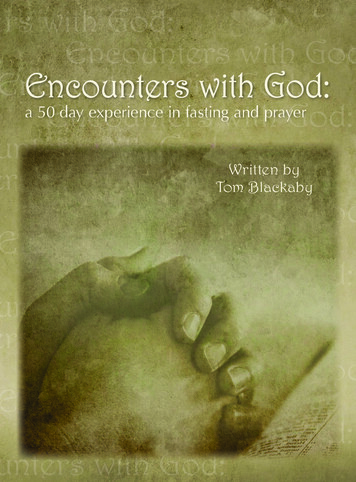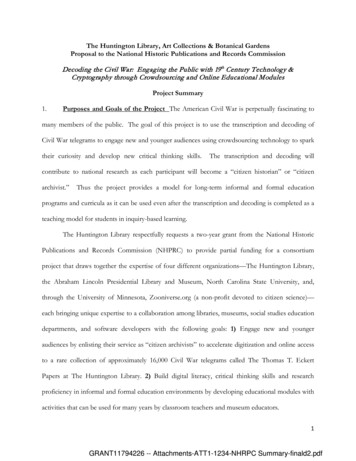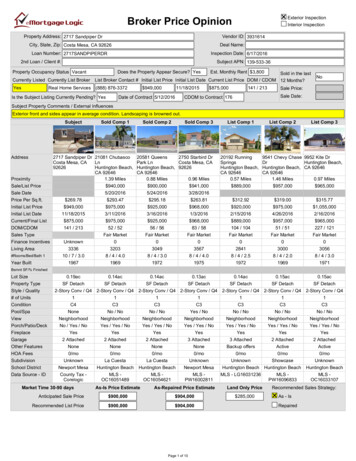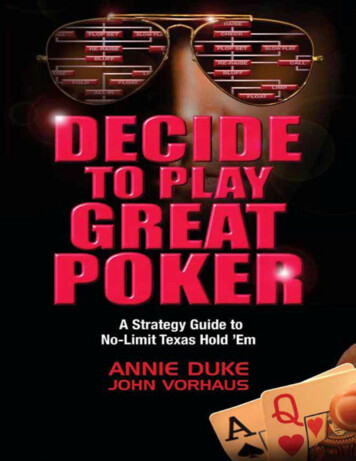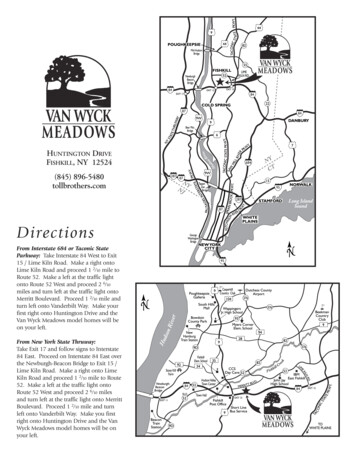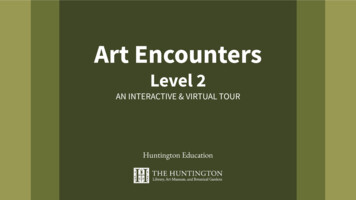
Transcription
Art EncountersLevel 2AN INTERACTIVE & VIRTUAL TOURHuntington Education
Welcome to the Art Encounters Level 2virtual tour!Each slide features an object with questions, activities, and linksto additional information.Henry and Arabella Huntington loved to collect art, books,and plants. What do you like to collect? Comic books? Coins?Funko POP! figures?In this interactive journey you’ll dive into the Art collection.Let’s go exploring!
Art VocabularyClick on a vocabulary word to start your tour!Each word relates to a type of artwork at The amicsPastelPrintOnce you have explored all six cards, click here!
PastelPowdered pigments combined together to form a crayon-like drawing instrument PickAnotherArtworkMary Cassatt was an American artist who moved to France to study art.While in France, she joined the Impressionist movement. Impressionistartists wanted to show an impression, or view, of everyday life.Many Impressionist artists like Mary Cassatt used pastels to create theirartwork. Pastel is a quick, easy-to-use medium. The colors can be blended,they don’t need time to dry like paint, and all the materials can fit in a box,making it portable. Are you interested in seeing a box of pastels from thistime period? Click here!Why do you think Mary Cassatt chose to use pastel as her artistic medium,as opposed to oil paint or watercolor? What do you think she was hopingto achieve?The girl is this portrait is named Françoise. How do you think Mary Cassattknew Françoise? Click here to find out! Why do you think she included a dog?Why do you think this scene was set inside instead of outdoors?ActivityImagine meeting Françoise. What would you talk about? Would you play with herdog? What questions would you ask her? Write a short story about your interaction.Click on these links to explore moreZoom in for a closer look at the artworkExplore other works by Mary CassattFrançoise Holding a Little Dog, Mary Cassatt, ca. 1906, pastel on paper.The Huntington Library, Art Museum, and Botanical Gardens.
PrintAn image or object that has been ink-transferred to a piece of paper via a stamp,plate, machine, or other technique PickAnotherArtworkLoretta Bennett is part of a group in Gee’s Bend, Alabama, known as theGee’s Bend Quilters Collective. They use recycled and found fabric andstitch them together to create beautifully designed quilts.Blues is a print of one of Bennett’s quilts. After she made her quilt,Bennett worked with printers at Paulson Fontaine Press to turn her quiltinto a print through the Intaglio process—a type of printmaking where thedesign is carved into a metal plate, creating grooves for inkWhat is the original work of art? The quilt? Or the print? Or are they bothworks of art?Do you like the colors chosen for the quilt? Or would you have useddifferent colors? Why? Based on the colors chosen, what do you thinkis the mood of the print? What makes you think that?ActivityWrite a four-line poem about this print. Think about what the mood of the print isand how the title is reflected in the work.Click on these links to explore moreExplore other prints by the Gee’s Bend QuiltersWatch a short video of printing of the Gee’s Bend quiltsBlues, Loretta Bennett, 2007, Color softground etching with spitbiteaquatint. The Huntington Library, Art Museum, and Botanical Gardens.
CeramicsObjects formed out of clay and fired at a high temperature in a kiln,an oven for pottery PickAnotherArtworkDoyle Lane began his career by making ceramic pots, then he startedcreating large “clay paintings.” This is an example, and it is really big.It is 17 x 8 feet!This work is made of 4,876 individual tiles. Each tile was hand formed,glazed, and fired in a kiln. Why do you think he chose this numberof tiles?Why do you think Lane chose to paint all of the tiles red? Do you likethat it is only red? Would you have added different colors?This work was commissioned for the Mutual Savings and Loan officesin Pasadena, California, by the architect, Welton Becket. Why mightBecket have asked Lane to create a “clay painting” to be displayedoutside a bank?ActivityDesign your own “clay painting.” How would you shape your individual tiles?How many would you include? What colors would you use? Would they be a solidcolor or would the tiles tell a story? Sketch your idea!Click on these links to explore moreZoom in to the artworkRestoring a Doyle Lane MuralWatch a time-lapse installation videoMutual Savings and Loan Mural (Red Tile Mural), Doyle Lane, 1964, glazedceramic. The Huntington Library, Art Museum, and Botanical Gardens.
EmbroideryNeedlework that creates a decorative design to embellish fabric Look closely at this embroidery piece. Zoom in for a closer lookat the work to notice the details. What do you see? What do you think it would feel like to touch this object? Would it feelsilky? Smooth? Rough? Bumpy? Why? This embroidery work was designed by Charles Francis Annesley Voysey. Itwas based on one of his patterns for wallpaper. However, this specificwork was intended to be hung and displayed in a room as art. The embroiderer is unknown. Why do you think the designer is known, butthe embroiderer was not documented? Who should get artistic credit?PickAnotherArtworkActivityDesign your own embroidery pattern. Will you combine animals and plants, likeVoysey did? Or will you choose a geometric design? Would you want yourembroidery piece to cover walls in your favorite room, or would you want toframe it and hang your creation as a work of art?Click on this link to explore moreExplore other embroidery items in the collectionSnake Amongst Flowers, designed by Charles Francis Annesley Voysey,embroidered by Unknown, British, 19th century, ca. 1895, silk and linen. TheHuntington Library, Art Museum, and Botanical Gardens.
Artist’s SketchbookA notebook for artists to sketch or draw their ideas Do you have a journal or a diary? Or maybe a place to brainstormideas or jot down notes or sketches? Samuel Howitt was a British artist who often featured animalsin his art. Howitt created an entire sketchbook dedicated to drawingmonkeys, and he included many different species.Explore other monkeys in this sketchbook. Do you have a favorite?Which one? Why? Why do you think Howitt chose to draw monkeys instead ofanother animal?PickAnotherArtworkActivityStart your own artist’s sketchbook! You can make your own notebookdigitally, fasten pieces of paper together, or you even use the SchoolPrograms Booklet. It is up to you. Use this space to brainstorm art ideas orto test out new art techniques or styles. Will you dedicate your sketchbookto one subject or art medium, or will it be a mix?Click on this link to explore moreView other artist’s sketchbooks in the collection - Book 1 and Book 2Monkey Sketchbook, Samuel Howitt, ca. 1817, watercolor over pencil.The Huntington Library, Art Museum, and Botanical Gardens.
BronzeA material created by mixing copper and tin PickAnotherArtworkEnrique Martínez Celaya, The Huntington’s artist in residence from 2019 to2021, cast this bronze sculpture. This artistic process includes first making ahollow mold of the sculpture. Then the mold is filled with melted elements(copper and tin), which is called casting. Once the melted liquid cools, the moldis removed to reveal the cast bronze sculpture.Celaya has lived all over the world. He was born in Cuba, grew up in Spain andPuerto Rico, and now lives and works in Culver City in Southern California.This life-sized sculpture depicts a boy carrying a house around his neck andshoulders. He is supporting himself with crutches. Do you think the housesymbolizes something to the boy?Celaya works in a variety of media. Why do you think he chose to create thiswork as a life-size bronze sculpture?Why do you think this bronze sculpture is titled The Gambler? Do you thinkit is a fitting title?ActivityWrite a short story about The Gambler. Where do you think the boy is going? Why is hecarrying a house on his shoulders? Why is he using crutches? Be descriptive andcreative in your story!Click on these links to explore moreZoom in for a closer look at the sculptureLearn more about Enrique Martínez CelayaThe Gambler, Enrique Martínez Celaya, 2010, bronze. The HuntingtonLibrary, Art Museum, and Botanical Gardens. Enrique Martínez Celaya.
Now that you have explored six different art topics, do youhave a favorite? Which one? Why do you like that one best?Was there an artwork you really didn’t like? Which one?Why don’t you like it?What is one thing you learned about art today?Thank you for coming on this journey with us!We would love to see the art and writing you made!#TheHAtHome
Becket have asked Lane to create a "clay painting" to be displayed outside a bank? . Snake Amongst Flowers, designed by Charles Francis Annesley Voysey, embroidered by Unknown, British, 19th century, ca. 1895, silk and linen. . Samuel Howitt, ca. 1817, watercolor over pencil. The Huntington Library, Art Museum, and Botanical Gardens .




